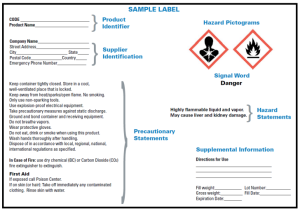The Globally Harmonized System (GHS)
Of Classification and Labeling of Chemicals
OSHA updated the Hazard Communication standard in 2012 to align with the Globally Harmonized System
(GHS)
Standard phrases and pictograms are now used to communicate chemical hazards
Labels must contain:
Name, Address and Telephone number of chemical manufacturer, importer or other responsible
party
Product Identifier-“name” of product
Signal Word
Hazard Statement(s)
Precautionary Statement(s)
Pictograms(s)
Signal Words: used to indicate the relative level of severity of the hazard, there are two signal words:
Danger-used for more severe hazards
Warning-used for less severe hazards
Hazard Statement(s): A statement assigned to a hazard class and category that describes the nature of the
hazard(s) of a chemical, including where appropriate the degree of hazard, e.g. Fatal if swallowed
Precautionary Statement(s): A phrase that describes recommended measures that should be taken to
minimize or prevent adverse effects resulting from exposure or improper storage or handling. Four types
of statements which have been assigned to hazard classes and categories:
Prevention
Response
Storage
Disposal
Pictograms: May include a symbol plus other graphic elements such as a border, background pattern or
color. Intended to convey specific information about the hazards of a chemical. Eight designated
pictograms and one non-mandatory. Black symbols on a white background, with a red diamond border.
Material Safety Data Sheets (MSDS) are now called Safety Data Sheets (SDS)


